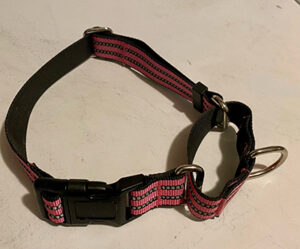By Fran Jewell

I don’t usually write much about equipment for dogs because I have always believed that equipment should be discussed and recommended for the individual dog. I also believe there is a time and place for the use of almost every piece of equipment. However, I recently spent some time with many of my NADOI colleagues. I had a few eye-openers and reinforcements for feelings I have had about some equipment. I am not a veterinarian, but I am confronted with harnesses on a daily basis. My colleagues did address the use of harnesses and collars with relationship to behavior. Behavior IS something I deal with every day.
I have not been much of a supporter of harnesses, although many people feel they do help with stopping pulling. Let’s face it—some harnesses are adorable! What I have seen are improperly fitted harnesses, and harnesses that dogs can get out of. Continued use of a harness can cause pulling, resulting in dogs wrenching their shoulders, backs, ribs, elbows and necks while wearing them.
Recently, I came across a study done in the UK that showed that natural movement was inhibited by all harnesses, especially the ones designed for attachment at the front. I wonder, too, if the straps around the chest inhibit breathing because of the pressure on the ribs. This could be enormously important for dogs with very short muzzles, like French bulldogs and the like. In one case I am aware of, a dog on a harness for every walk suffered permanent spinal damage.
Now I see that many breeders are sending puppies home in harnesses. This rather terrifies me for several reasons. First, I don’t believe this can be healthy for developing structure of a puppy. Secondly, almost all harnesses lay across the brachial nerve plexus that causes pain for the dog. When everyone is touting how humane harnesses are, I have to ask, “Are they, really?”
I was unable to find any studies on the Internet about the potential of brachial plexus nerve damage related to harnesses, yet I suspect at some point there will be. This nerve is vital to the proper function of the front legs and it can be damaged or impaired.
While everyone feels they are being more humane when they use harnesses, I am not quite sure I can buy into that. In most cases where I see dogs in harnesses, the dogs are still misbehaving. There are, of course, reasons for harnesses that can be lifesaving. As with everything, we have to decide if the benefits outweigh the risks. My feeling is to use another piece of equipment unless the harness is necessary for a certain activity to keep the dog safe.
Now the question is, “What do you use instead?” Well, another fallacy is that flat collars are the best collars to use. The flat collar is supposed to be the most humane. There is also the concern that flat collars hurt the dog’s trachea. Again, I am not a veterinarian, but there is some logic to this. When a dog is wearing a flat, buckle collar with a leash, the leash puts pressure on the opposite side of the neck from where the leash is attached. A flat, buckle collar can, indeed, influence damage, especially for some dogs with known breathing and soft-tissue issues.
The alternative is what is called a martingale collar, or limited slip collar. This collar allows for pressure to be applied evenly around the dog’s neck without choking when the leash is attached, so the amount of pressure is not directed to one area. For many years I recommended these collars for puppies because it does not allow the puppy to learn how to escape the buckle collar. I almost lost one of my own dogs 25 years ago in downtown Ketchum because she slipped out of her collar. She ran onto Sun Valley Road! From then on, I personally always used martingale collars so my pups never learned how to escape from a collar in the first place.
There are many brands of martingale collars. Some are much nicer than others and prices vary enormously. For any breed, this collar is even preferred over a harness because it has so much less potential to physically hurt your dog.
Equipment is a very important issue for dog owners. All things should be considered when you start placing them on your dog. Don’t fall prey to the glamorous ads and pretty colors! Do some research and consult a professional if you are concerned.
Fran Jewell is an IAABC Certified Dog Behavior Consultant, NADOI Certified Instructor and the owner of Positive Puppy Dog Training, LLC in Sun Valley. For more information, visit positivepuppy.com or call 208-578-1565.
